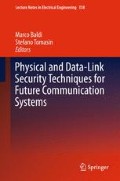Abstract
The wiretap coding problem has been addressed since a long time from an information theoretic standpoint. This has permitted to find the ultimate achievable limits under the hypothesis of random coding, which however is far from practice. Some families of practical codes have also been already considered in this scenario, but their achievable secrecy has mostly been assessed in asymptotic conditions (i.e., under the hypothesis of infinite codeword length) and using discrete channel models. In this chapter, we analyze the performance of practical codes over the Gaussian wiretap channel by using suitable metrics which take into account the codeword length and even the specific code structure. This way, we are able to assess the performance of real codes in the finite code length regime, and compare it with the ultimate achievable limits. We focus on low-density parity-check codes as they are among the most viable candidates for the use in this setting.
Access this chapter
Tax calculation will be finalised at checkout
Purchases are for personal use only
Notes
- 1.
Obviously, in the finite length regime Bob’s error probability cannot be vanishing. Therefore, in order to apply these metrics in such a regime, the reliability target must be converted into requiring that Bob achieves some sufficiently small error probability.
References
Andersson M, Rathi V, Thobaben R, Kliewer J, Skoglund M (2010) Equivocation of Eve using two edge type LDPC codes for the binary erasure wiretap channel. In: Proceedings of the 44th Asilomar conference on signals, systems and computers, Pacific Grove, California, pp 2045–2049
Baldi M, Bianchi M, Chiaraluce F (2012) Coding with scrambling, concatenation, and HARQ for the AWGN wire-tap channel: a security gap analysis. IEEE Trans Inf Forensics Secur 7(3):883–894
Baldi M, Chiaraluce F, Laurenti N, Tomasin S, Renna F (2014) Secrecy transmission on parallel channels: theoretical limits and performance of practical codes. IEEE Trans Inf Forensics Secur 9(11):1765–1779
Baldi M, Ricciutelli G, Maturo N, Chiaraluce F (2015) Performance assessment and design of finite length LDPC codes for the Gaussian wiretap channel. In: Proceedings of IEEE ICC 2015—workshop on wireless physical layer security, London, United Kingdom, pp 446–451
Bellare M, Tessaro S, Vardy A (2012) Semantic security for the wiretap channel. In: Safavi-Naini R, Canetti R (eds) Advances in cryptology—CRYPTO 2012, vol 7417, Lecture Notes in Computer Science, Springer, Berlin, pp 294–311
Bloch M, Barros J (2011) Physical-layer security: from information theory to security engineering, 1st edn. Cambridge University Press, Cambridge
Cheraghchi M, Didier F, Shokrollahi A (2012) Invertible extractors and wiretap protocols. IEEE Trans Inf Theory 58(2):1254–1274
Chung SY, Richardson TJ, Urbanke RL (2001) Analysis of sum-product decoding of low-density parity-check codes using a Gaussian approximation. IEEE Trans Inf Theory 47(2):657–670
Şaşoğlu E, Vardy A (2013) A new polar coding scheme for strong security on wiretap channels. In: Proceedings of IEEE international symposium on information theory, Istanbul, Turkey, pp 1117–1121
Harrison WK, Almeida J, Bloch MR, McLaughlin SW, Barros J (2013) Coding for secrecy. IEEE Signal Process Mag 30(5):41–50
Hu XY, Eleftheriou E, Arnold DM (2001) Progressiveedge-growth Tanner graphs. In: Proceedings of IEEE global telecommunication conference (GLOBECOM’01), San Antonio, Texas, pp 995–1001
Klinc D, Ha J, McLaughlin S, Barros J, Kwak BJ (2011) LDPC codes for the Gaussian wiretap channel. IEEE Trans Inf Forensics Secur 6(3):532–540
Koyluoglu OO, El Gamal H (2010) Polar coding for secure transmission and key agreement. In: Proceedings of IEEE international symposium on personal, indoor, and mobile radio communications (PIMRC 2010), Istanbul, Turkey, pp 2698–2073
Leung-Yan-Cheong S, Hellman M (1978) The Gaussian wire-tap channel. IEEE Trans Inf Theory 24(4):451–456
Liang Y, Poor HV, Shamai (Shitz) S (2008) Information theoretic security. Found Trends Commun Inf Theory 5(4–5):355–580
Liu R, Liang Y, Poor HV, Spasojević P (2007) Secure nested codes for type II wiretap channels. In: Proceedings of IEEE information theory workshop, Lake Tahoe, California, pp 337–342
Mahdavifar H, Vardy A (2010) Achieving the secrecy capacity of wiretap channels using polar codes. In: Proceedings of IEEE international symposium on information theory, Austin, Texas, pp 913–917
Rathi V, Andersson M, Thobaben R, Kliewer J, Skoglund M (2009) Two edge type LDPC codes for the wiretap channel. In: Proceedings of 43rd Asilomar conference on signals, systems and computers, Pacific Grove, California, pp 834–838
Rathi V, Urbanke R, Andersson M, Skoglund M (2011) Rate-equivocation optimal spatially coupled LDPC codes for the BEC wiretap channel. In: Proceedings of IEEE international symposium on information theory, St. Petersburg, Russia, pp 2393–2397
Richardson TJ, Urbanke RL (2001) The capacity of low-density parity-check codes under message-passing decoding. IEEE Trans Inf Theory 47(2):599–618
Subramanian A, Thangaraj A, Bloch M, McLaughlin SW (2011) Strong secrecy on the binary erasure wiretap channel using large-girth LDPC codes. IEEE Trans Inf Forensics Secur 6(3):585–594
Thangaraj A, Dihidar S, Calderbank A, McLaughlin S, Merolla JM (2007) Applications of LDPC codes to the wiretap channel. IEEE Trans Inf Theory 53(8):2933–2945
Wong CW, Wong TF, Shea JM (2011) LDPC code design for the BPSK-constrained Gaussian wiretap channel. In: Proceedings of IEEE global telecommunication conference (GLOBECOM’11), Houston, Texas, pp 898–902
Wong CW, Wong TF, Shea JM (2011) Secret-sharing LDPC codes for the BPSK-constrained Gaussian wiretap channel. IEEE Trans Inf Forensics Secur 6(3):551–564
Wyner AD (1975) The wire-tap channel. Bell Syst Tech J 54(8):1355–1387
Acknowledgments
This work was supported in part by the MIUR project “ESCAPADE” (Grant RBFR105NLC) under the “FIRB—Futuro in Ricerca 2010” funding program.
Author information
Authors and Affiliations
Corresponding author
Editor information
Editors and Affiliations
Rights and permissions
Copyright information
© 2016 Springer International Publishing Switzerland
About this paper
Cite this paper
Baldi, M., Chiaraluce, F., Maturo, N., Tomasin, S. (2016). Performance Analysis of Transmission over AWGN Wiretap Channels with Practical Codes. In: Baldi, M., Tomasin, S. (eds) Physical and Data-Link Security Techniques for Future Communication Systems. Lecture Notes in Electrical Engineering, vol 358. Springer, Cham. https://doi.org/10.1007/978-3-319-23609-4_4
Download citation
DOI: https://doi.org/10.1007/978-3-319-23609-4_4
Published:
Publisher Name: Springer, Cham
Print ISBN: 978-3-319-23608-7
Online ISBN: 978-3-319-23609-4
eBook Packages: EngineeringEngineering (R0)

